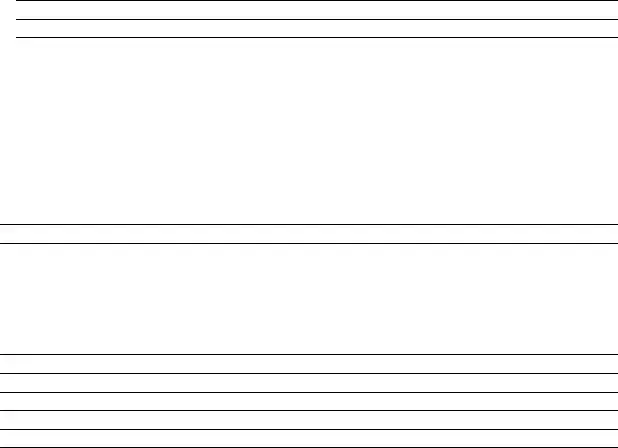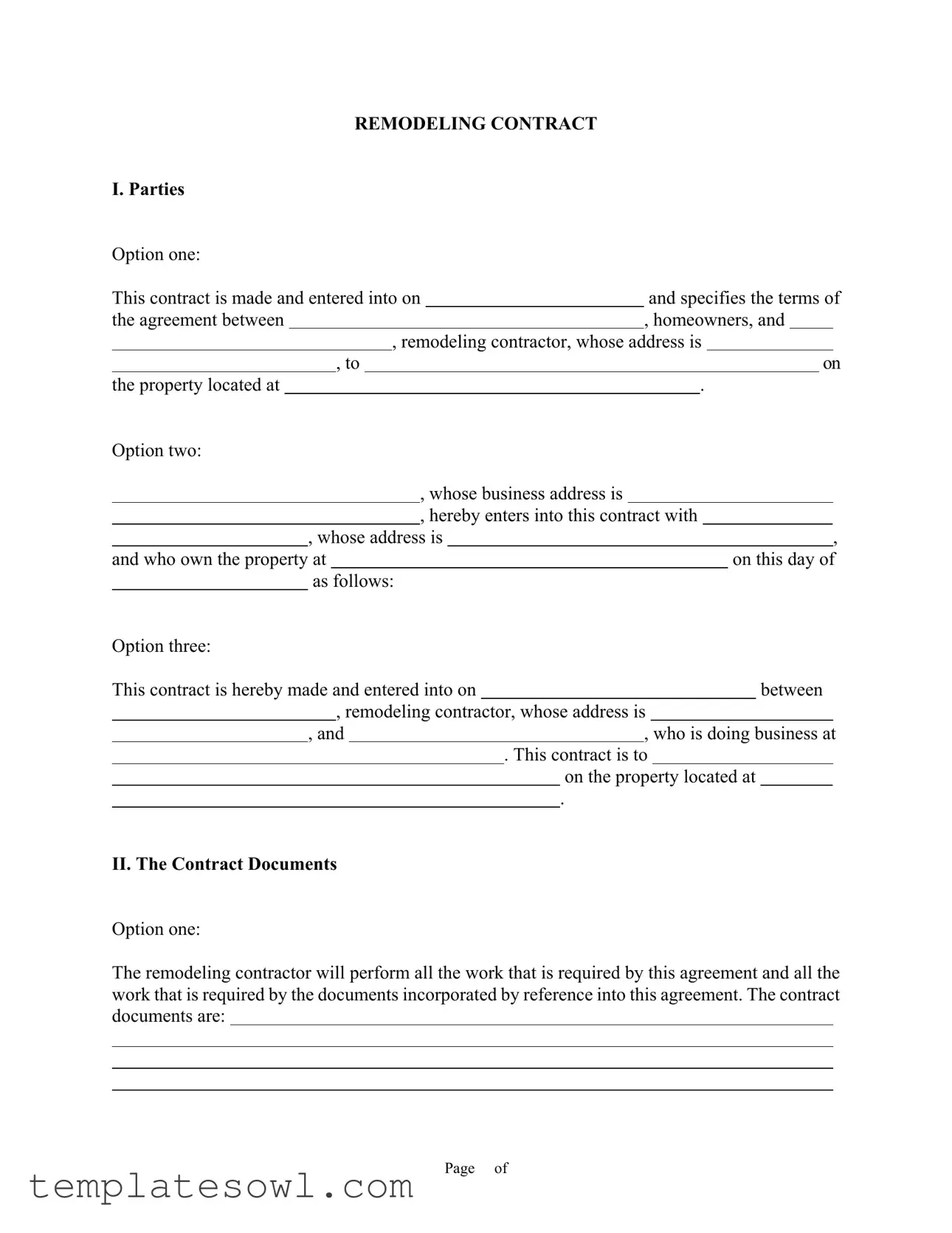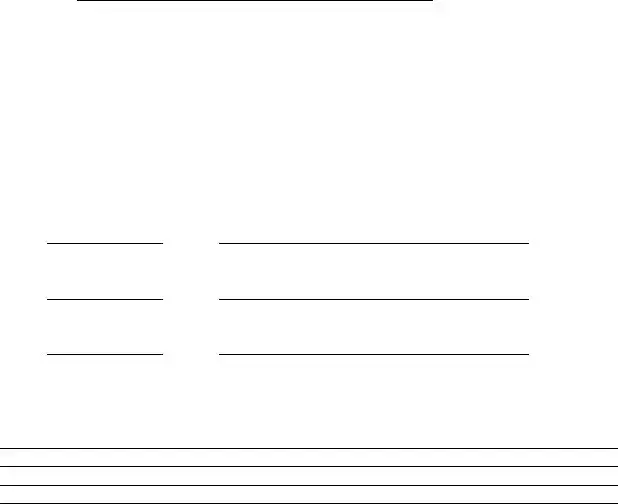|
|
|
|
|
|
|
|
|
|
|
|
|
|
|
|
REMODELING CONTRACT |
|
|
|
|
|
|
I. Parties |
|
|
|
|
|
|
Option one: |
|
|
|
|
|
|
This contract is made and entered into on |
|
and specifies the terms of |
the agreement between |
|
, homeowners, and |
|
|
|
|
|
|
|
, remodeling contractor, whose address is |
|
|
|
|
|
, to |
|
|
|
|
|
on |
the property located at |
|
|
. |
|
|
|
|
Option two:
,whose business address is
,hereby enters into this contract with
|
, whose address is |
|
|
, |
and who own the property at |
|
|
|
|
|
|
|
on this day of |
|
as follows: |
|
|
|
|
|
|
|
|
|
|
Option three: |
|
|
|
|
|
|
|
|
|
|
This contract is hereby made and entered into on |
|
|
|
|
|
|
|
|
between |
|
|
|
, remodeling contractor, whose address is |
|
|
|
, and |
|
|
|
|
, who is doing business at |
|
|
|
|
|
|
|
. This contract is to |
|
|
|
|
|
|
|
|
|
|
on the property located at |
|
|
|
|
|
|
|
|
|
. |
|
|
|
|
|
|
|
II. The Contract Documents
Option one:
The remodeling contractor will perform all the work that is required by this agreement and all the work that is required by the documents incorporated by reference into this agreement. The contract documents are:

Option two:
The contract documents include the terms of this contract and, by reference, the documents listed below:
1.
2.
3.
III. The Scope of the Work
Option one:
The remodeling contractor will furnish all the labor, materials, and equipment necessary to complete the alterations and improvements described in the contract documents. The work does not include
.
Option two:
The remodeling contractor will furnish the labor and materials necessary to do the following:
IV. Change Orders
All change orders must be in writing and signed by all the parties. The owners agree that changes resulting in the furnishing of additional labor or materials will be paid for prior to the commencement of the extra work. The owners agree that either of them may sign a change order, and that signature will be binding on both.
V. Permits, Licenses, and Approvals
The remodeling contractor will obtain and pay for local building and construction permits, and will obtain and pay the fees for the governmental inspections that are necessary for the construction and occupancy of the finished structure, except as otherwise provided in this contract. The owners will secure and pay for any easements, variances, zoning changes, necessary modifications of restrictive
covenants, or other actions. The owners will indicate the property lines to the remodeling contractor and will provide boundary stakes by a licensed land surveyor if the owners are in doubt about the property boundaries.
VI. Insurance and Risk of Loss
The owners agree to maintain insurance covering the replacement cost of the improvement under contract in the event of loss through fire, casualty, storm or other disasters, and theft of materials from the site. Before work begins, the property owner will furnish a certificate of that insurance to the remodeling contractor. The remodeling contractor agrees to maintain workers’ compensation insurance and liability insurance to protect the owners from liability claims for damages because of bodily injury, including death, and from liability for damages to property. Before beginning the work, the remodeling contractor will furnish a certificate of that insurance to the property owner.
VII. Access
The property owner will allow free access to work areas for workers and vehicles and will allow areas for the storage of materials and debris. Driveways will be kept clear for the movement of vehicles during work hours. The remodeling contractor will make reasonable efforts to protect driveways, lawns, shrubs, and other vegetation.
VIII. Site Conditions
The property owners acknowledge that this contract is based upon the remodeling contractor’s observation of conditions. Conditions which could not be known by a reasonable inspection, such as termite damage, hidden water damage, hidden code violations, or other concealed conditions, may require extra labor or materials, which are not part of this contract. If such hidden conditions are discovered, the remodeling contractor will notify the property owner and will attempt to reach an agreement for a change order to this contract that addresses those problems.
IX. Payment |
|
|
Option one: |
|
|
The customer will pay an hourly fee for labor in the amount of $ |
|
for all time spent |
on the job plus the cost of all materials. |
|
|
Option two:
The property owner will pay the cost of all materials used in construction plus delivery and handling

costs, the wages of all carpenters and other workers, and the cost of all subcontractors. The owner
will also pay a fixed fee of $ |
|
to the contractor for overhead and profit. |
Option three:
The owner will pay the cost of all materials used in construction plus delivery and handling costs, the wages of all carpenters and other workers for the actual time spent on the job, and the cost of all
subcontractors. The owner will also pay percent of those costs to the contractor for the contractor’s overhead and profit.
Option four:
The owner will pay the cost of all materials used in construction plus delivery and handling costs, the wages of all carpenters and other workers for the actual time spent on the job, and the cost of all
subcontractors. The owner will also pay percent of those costs to the contractor for the
contractor’s overhead and profit. The contractor guarantees that the total cost of the work will not
exceed the amount of $ |
|
, excluding the cost of change orders. |
X. Payment Schedule
Option one:
Payments for the work will be due as follows:
|
|
|
|
|
|
|
|
|
A deposit in the amount of |
|
percent of the contract price will be due upon contract signing. |
$ |
|
is due on the date of |
|
|
. |
$ |
|
is due on the date of |
|
|
. |
$ |
|
is due on the date of |
|
|
. |
The final payment of $ |
|
|
is due upon substantial completion. Before final payment, |
the remodeling contractor will deliver a lien release to the customer.
If payments due to the remodeling contractor are not paid in accordance with the payment schedule in this contract, the remodeling contractor may suspend work until the scheduled payment is made.
Option two:
Payments for the work are due as follows:
A deposit in the amount of |
|
percent of the contract price is due upon contract signing. |
Additional payments will be due as the following items of work listed below are completed.
When each payment is due, the remodeling contractor will prepare a statement of money due in writing and submit it to the owners. All payments are due from the property owner no later than ten days after receipt of the statement. The remodeling contractor will furnish lien releases for work completed through each request, upon receipt of payment.
%of the remaining contract price is due when
%of the remaining contract price is due when
%of the remaining contract price is due when
%of the remaining contract price is due when
The remaining contract price is due upon the substantial completion of the work. Upon final payment the remodeling contractor will deliver a release of all liens.
If payments due to the remodeling contractor are not paid within ten days of the written demand, the remodeling contractor may suspend work until payment is made.
XI. Final Inspections and Liens
Upon notification by the remodeling contractor of substantial completion of the work, the owners and the remodeling contractor will inspect the work performed, and at that time the owners will prepare a punch list that identifies any incomplete work or deficiencies in workmanship or materials. The owners may retain the value of the punch list work from the final payment until the punch list items are complete. Completion of the punch list items must be made within days from the
date of the punch list preparation. When the punch list items are completed, the owners will pay the remodeling contractor the balance of the contract price within days of the demand. At that
time, the remodeling contractor will deliver to the property owners a release of all liens.
XII. Warranties
The remodeling contractor guarantees the work will meet trade standards of good workmanship. The remodeling contractor will make every effort to blend existing textures, colors, and planes, but exact duplication is not guaranteed. The remodeling contractor warrants that materials of good quality will be selected. The contractor will maintain all manufacturers’ warranties. The customer is limited to the manufacturers’ warranties for defects in the manufacture of materials. All contractors’ warranties
are limited to a period of no more than . The remodeling contractor’s warranties are limited to the cost of labor and materials only, and exclude ordinary wear and tear or abuse by others.
XIII. Dispute Resolution
All the parties will cooperate with each other to resolve conflicts informally. In the event that is not possible, conflicts between the parties will be resolved by
provided by. The conflict will be decided
according to the Construction Industry Rules of the American Arbitration Association, and the laws of the state where the project is located. The arbitrator will award reasonable costs and expenses, including attorney fees, to the prevailing party.
XIV. Signatures
We, the undersigned, have read and understood this entire contract, including documents attached by reference. We acknowledge that this document constitutes the entire agreement between the parties. This contract is not binding upon the remodeling contractor or the property owners until it is signed by all parties.
Dated:Signed:
Contractor
Dated:Signed:
Owner
Dated:Signed:
Owner
Contract documents:
Page of





